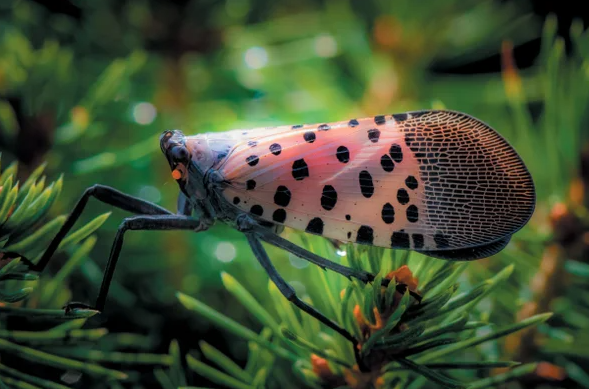How to Protect Trees from Spotted Lanternflies

Spotted lanternflies (SLF) are an invasive species that seriously threaten trees, plants, and agriculture. Originally from Asia, they have rapidly spread across various regions in the U.S., feeding on the sap of trees and damaging crops. These pests are hazardous because they damage various tree types, such as fruit trees, oaks, and maples, degrading their health and leaving them susceptible to other illnesses. Protecting trees from spotted lanternflies has become essential to prevent widespread damage to forests, orchards, and urban landscapes. Various control methods are available, ranging from physical barriers to chemical treatments. Key Takeaways: A Multi-Method Approach is Essential: No single method can fully protect trees from spotted lanternflies. The most effective protection combines tree banding, insecticide sprays, and egg mass removal. Early Detection and Consistent Monitoring are Key: Spotted lanternflies are more easily controlled in their early stages, especially as nymphs. Always check signs of infestation, such as egg masses or early-stage nymphs. Environmentally Safe Methods are Available: Eco-friendly solutions such as neem oil and biological controls exist for those concerned about environmental harm. These methods offer a safer alternative to chemical treatments while still being effective in reducing SLF populations. Tree Banding Tree banding is a popular method for controlling spotted lanternfly populations by trapping the nymphs as they crawl up tree trunks. Sticky bands are placed around the trunk of a tree, creating a physical barrier that captures nymphs on contact. These bands are particularly influential because nymphs must climb upward to reach the leaves, where they feed. How It Works: Sticky bands are wrapped around the trunk, creating a sticky surface that traps the nymphs as they move upwards in search of food. As nymphs crawl over the band, they become stuck, preventing them from reaching the canopy and continuing their life cycle. Materials to Use: Commercial sticky bands are designed explicitly for tree banding. DIY alternatives, such as double-sided tape or adhesive-coated paper, can be combined with plastic wrap. It’s essential to check the bands regularly, as they can become filled with insects or lose stickiness over time. How to Avoid Trapping Non-Target Species: Use mesh or wire guards around the sticky bands to prevent birds, squirrels, or other animals from accidentally getting stuck. Alternatively, sticky bands should be installed higher up the trunk, out of reach of small animals. Wildlife-friendly adhesive bands are also available to minimize harm to non-target species. Tree Wrapping Tree wrapping involves wrapping materials like burlap or fabric around the tree trunk. This method creates a protective layer that intercepts spotted lanternflies during migration, making it a simple yet effective tool for controlling SLF populations. How It Works: Burlap or fabric is wrapped tightly around the tree, usually in two layers, with the top layer left loose. As the nymphs or adult lanternflies migrate upward, they get trapped between the layers of fabric. Once trapped, they can be manually removed and destroyed. Benefits of Eco-Friendly and Reusable Options: Burlap is a natural and biodegradable material, making it an eco-friendly choice for tree protection. Fabric wraps can be reused multiple times throughout the season, reducing waste. Wrapping trees with these materials offers a chemical-free alternative, suitable for those concerned about the environment or for trees in areas with heavy wildlife activity. Insecticide Sprays Insecticide sprays are widely used to control spotted lanternfly populations by directly targeting tree pests. Two main types of insecticides are used: systemic and contact sprays. Type of Insecticide How It Works Best For Systemic It is absorbed into the tree’s tissues and affects SLF when they feed on the tree sap. Long-term protection, heavy infestations. Contact Sprays It kills SLF on contact but does not offer long-term protection. Immediate action for small, localized infestations. Safe Application Methods: Timing of Application: Insecticide sprays should be applied when spotted lanternflies are most active (typically late spring through fall). Avoiding Harm to Beneficial Insects: To protect bees, butterflies, and other pollinators, avoid applying sprays during blooming periods or in areas where beneficial insects are active. Opt for selective insecticides that target SLF while minimizing impact on non-target species. Weather Considerations: Apply sprays when calm, as the wind can carry the spray to unintended areas. Avoid spraying before rainfall to prevent runoff into water systems. Considerations for Specific Tree Species: Some tree species are more susceptible to insecticide damage. For example, fruit trees may need special care, as insecticides can affect fruit production. In such cases, using products labeled safe for fruit-bearing trees is essential. Systemic insecticides should not be used on trees that are near water sources, as they can leach into the soil and affect aquatic life. Insecticide Soil Treatment Soil treatments involve applying systemic insecticides to the tree’s base, which are absorbed through the roots and transported throughout the tree. This method provides long-term protection by killing spotted lanternflies as they feed on the tree’s sap. How It Works: When systemic insecticides are sprayed on the ground surrounding a tree, the roots absorb the poison. The insecticide moves through the tree’s vascular system, targeting SLF that feed on the tree sap. Pros Cons Long-lasting protection for several months. Potential for groundwater contamination. Targets SLF throughout their life cycle. Can harm beneficial soil organisms. Suitable for large trees and heavy infestations. It is expensive and may require professional application. Adequate for Larger Infestations: Soil treatments are particularly effective for trees experiencing a severe infestation of SLF. They provide consistent protection, as the insecticide is continuously present in the tree’s sap for an extended period. This method benefits large trees that are difficult to treat with sprays alone. Long-Term Protection but with Environmental Concerns: While soil treatments offer long-term protection, they raise concerns about environmental impact. Insecticides have the potential to seep into the groundwater and contaminate it, harming surrounding plants and animals. It’s essential to follow application guidelines carefully and avoid overuse, especially near sensitive ecosystems such as rivers, ponds, or areas with high wildlife activity. Environmental Considerations: Use soil treatments as a last resort when other




